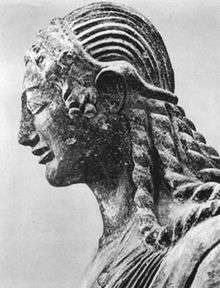Murlo cowboy
The name Murlo cowboy[1] is applied to a set of more than a dozen Etruscan acroteria from the sixth century BCE held at the museum of the Poggio Civitate at Murlo in the Province of Siena, Tuscany, Italy.[2]

Artist's impression of the Murlo cowboy.
The major piece of the group is a seated terracotta statue with a wide-brimmed hat reminiscent of a cowboy hat.[3] The statue probably represents a haruspex.
On Etruscan buildings, statues of gods, heroes, or ancestors were often placed on the ridges of roofs to protect votive offerings.
References
- Larissa Bonfante, Etruscan life and afterlife: a handbook of Etruscan studies, p. 133.
- O'Donoghue, E. (2013). The Mute Statues Speak: The Archaic Period Acroteria from Poggio Civitate (Murlo). European Journal of Archaeology, 16(2), 268-288. doi:10.1179/1461957112Y.0000000029
- Jean-Paul Thuillier, Les Étrusques, la fin d'un mystère, p. 38–39.
Bibliography
- 'The Murlo Cowboy: problems of reconstruction and interpretation' in Deliciae Fictiles, ed. Eva Rystedt, Charlotte Wikander and Örjan Wikander (Acta Instituti Romani Regni Sueciae, series in 4°, vol. 50, Stockholm, 1993) p. 117–121.
This article is issued from Wikipedia. The text is licensed under Creative Commons - Attribution - Sharealike. Additional terms may apply for the media files.
